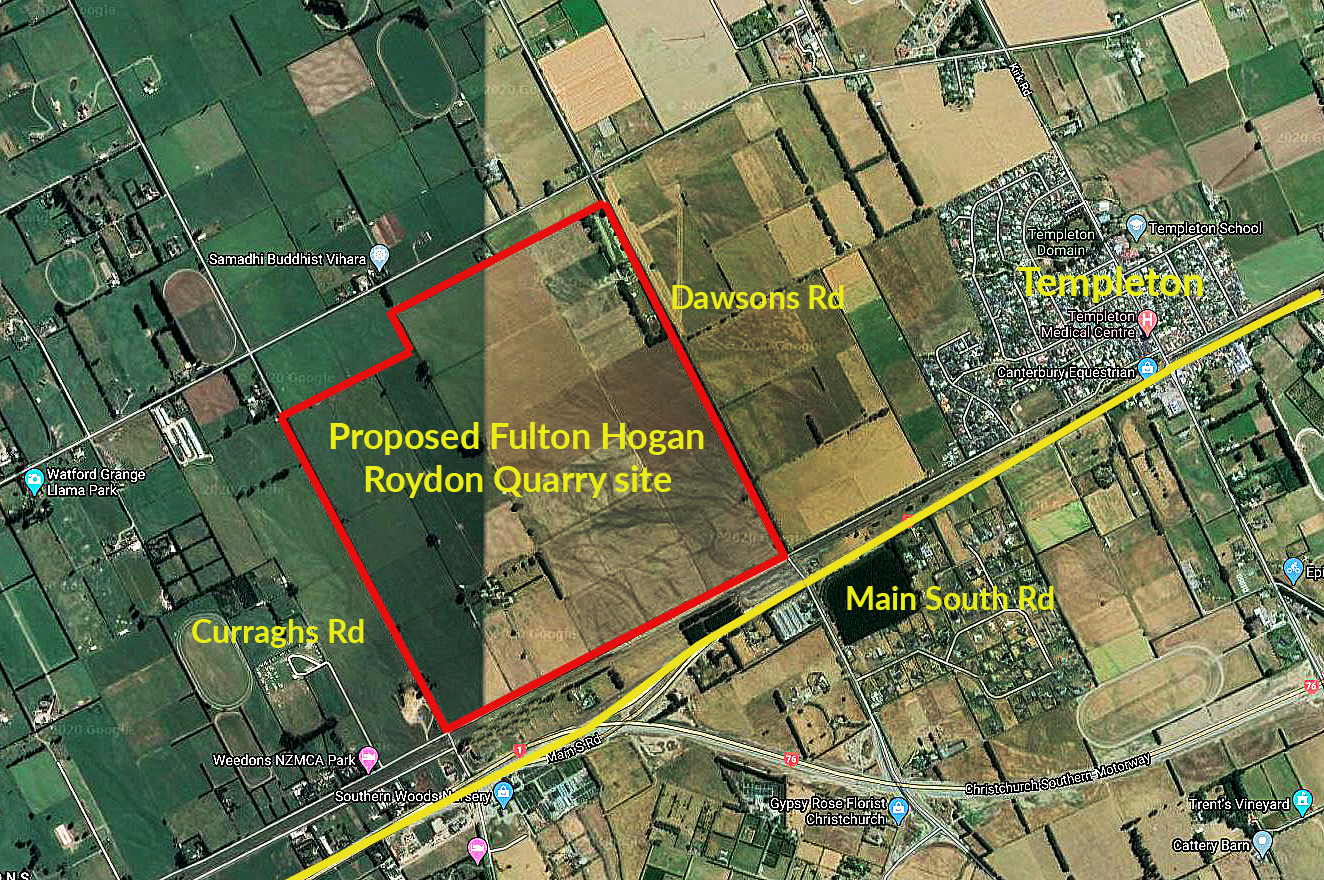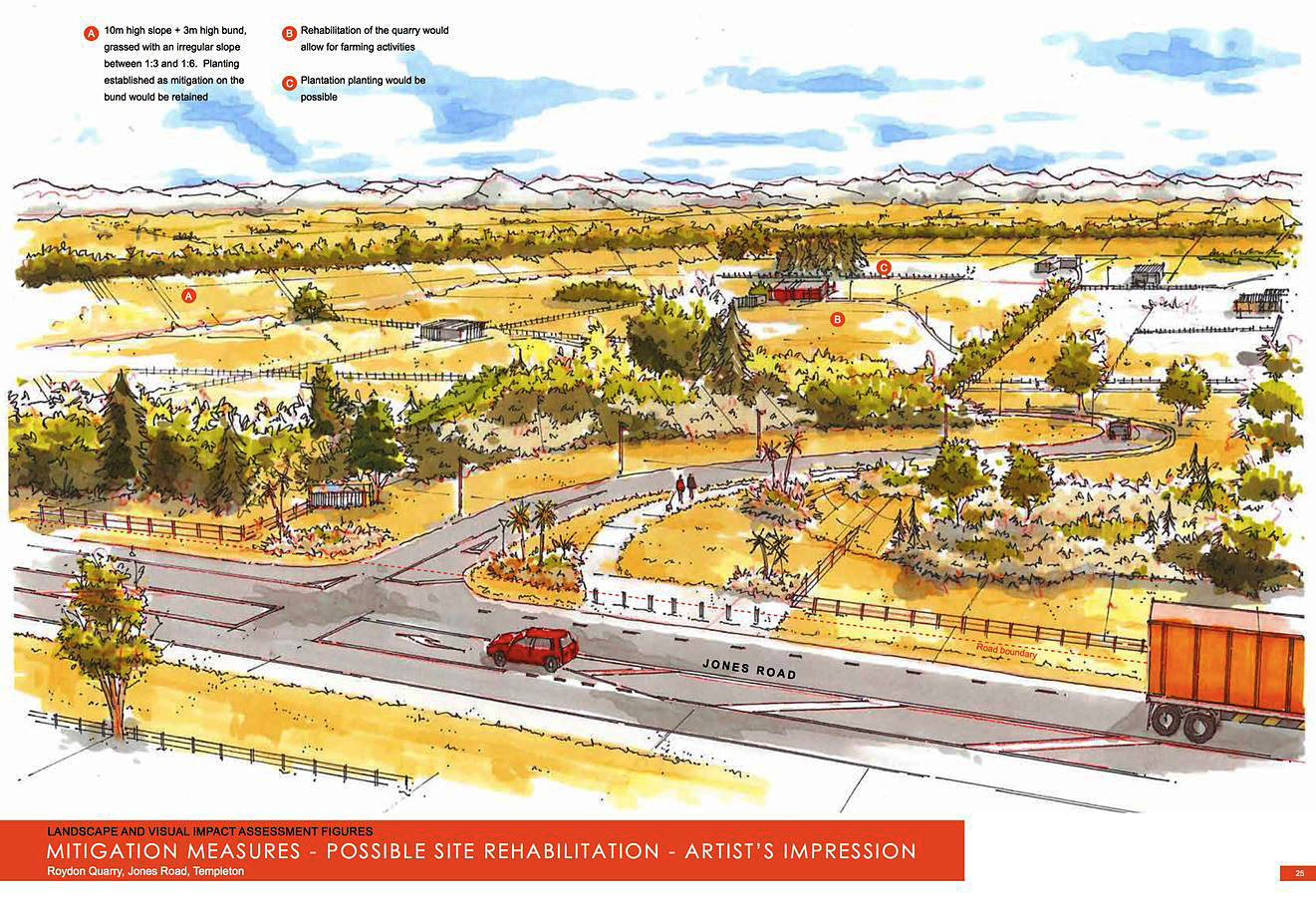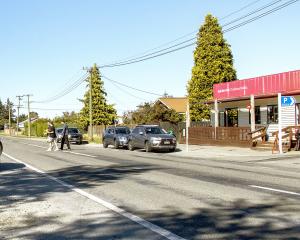
The roading giant was given resource consent in April to build a 170ha quarry close to State Highway 1 between Templeton and Weedons.
Residents living near the site were unsuccessful in a bid to stop the consent being granted.
Now Fulton Hogan is appealing conditions imposed which, if successful, could see less monitoring of dust, work able to be carried out at night and on Sundays and heavy trucks be able to use roads in the area which are not part of the resource consent.
Nearby resident Simon Moore said he was “disgusted” with Fulton Hogan’s appeal.
“The dust has always been one of the top issues for us. A condition being appealed calls for four regulatory certified PM10 monitors and Fulton Hogan want just one permanent one. I am speechless, to be honest. We didn’t even think four was enough,” he said.

Said Mr Moore: “In Canterbury, the concentration is worse due to the nature of the rocks we have, greywacke. I think it is our next asbestos issue. It can cause lung disease, silicosis it’s called.
“From what I have read and seen, it is our next issue for residents and workers.”
One of the 15 conditions Fulton Hogan is appealing is the requirement to design and implement a 12-month respirable crystalline silica monitoring programme and prepare a report on the results within one month of its completion.
Fulton Hogan wants a two, four-month monitoring campaigns instead.
The company says the financial impact of the conditions is unnecessarily onerous when considered in light of the low potential for RCS impacts, according to expert evidence.
Fulton Hogan South Island general manager Craig Stewart did not answer specific questions put to him by The Star about the appeal.

“We are actively and constructively engaged in the Environment Court process and recognise that determines the outcome from this stage of the Resource Management Act process.”

Weedons resident Stephen Bain has lodged an appeal in the Environment Court to overturn the commissioners’ decision.
“I think it was a strategic move that they have made because of my appeal. I don’t think they were going to do it until they saw other people were appealing,” said Mr Bain.
The approval of the quarry – which granted consent for 35 years – imposed a number of conditions, including setting up a dust management plan, truck movements limited to 1200 a day and no work can take place at night during the quarry’s first five years.
The Christchurch City Council has also became involved.
It decided to become a party to proceedings on behalf of the Hornby-Halswell-Riccarton to try and stop the conditions of the resource consent being changed. The community board has been prompted by Templeton residents.

•Depositing clean fill is only allowed between 6-8pm Monday to Saturday. Fulton Hogan wants it changed so the activity can occur during evenings, night time and Sundays.
•Heavy vehicle movements leaving or accessing the quarry need to use the direct route comprising State Highway 1, Jones and Dawsons Rds. Fulton Hogan wants it changed so it just has to take all practicable steps to ensure the vehicles associated with the quarry do not travel on those roads.
•Loaded heavy vehicles arriving at the site must have their load covered. Fulton Hogan wants this condition removed.
•Heavy vehicles with aggregate or other quarry material leaving the site must cover their load and have it dampened with water spray. Fulton Hogan wants it changed so that the vehicles must either cover their load or have it dampened.
•Once a year ECan may serve notice of its intention to review the conditions of these consents for the purposes of (amongst other things) “off-setting or compensating for any adverse effects on human health arising from suspended particulate matter (including dust and respirable crystalline silica) generated by quarry activities.” Fulton Hogan seeks the removal of the sub-paragraph referencing adverse health effects.
• Four regulatory certified PM10 monitors and two dust management monitors are to be installed prior to quarry activities occurring and during operations. Fulton Hogan wants it changed to require one permanent, regulatory certified monitor and four calibrated, mobile monitors.
•Prior to the start of quarrying, the consent holder must design and implement a Respirable Crystalline Silica monitoring programme in consultation with the Canterbury District Health Board and ECan and prepare a report on the results of the 12-month programme within one month of its completion. Fulton Hogan is proposing two, 4-month-long monitoring campaigns rather than one 12-month campaign.
•Quarry activities (except dust suppression measures) within 250m of a sensitive receptor location must not be undertaken when the wind direction places quarry activities directly upwind of the sensitive receptor location and the wind speed reaches or exceeds 7 m/s. Fulton Hogan wants it changed so only a subset of the activities that may occur on-site are required to stop under certain meteorological conditions.
• It must take all reasonably practicable measures to minimise the discharge of dust from quarry activities which include ensuring trucks leaving the site with loads of fine material and trucks entering the site with loads of clean fill are covered. Fulton Hogan wants it changed so that trucks can alternatively pass under a water spray boom.
•Should the ability to take water cease at any time, the consent holder must cease quarry activities requiring water usage to manage dust. Fulton Hogan wants it changed so the company will assess the need to temporarily cease some or all parts of operations itself.
•Excavation of aggregate and deposition of clean fill must only occur where the quarry floor maintains at least 1m separation depth to groundwater. Fulton Hogan is seeking a minor change so that permissible excavation depths are defined by reference to an RL level, as opposed to metres below ground level.
•Should the groundwater level increase so that the separation is less than 1m between the measured groundwater levels and the current ground level within the active quarry floor quarry site, Fulton Hogan must apply virgin materials to that area, so as to reestablish a 1m separation distance throughout the site. Fulton Hogan wants it changed to include that this requirement does not apply to any areas which have already been rehabilitated.
•If the results of the second groundwater samples show an exceedance of the trigger concentrations, the consent holder must sample all domestic wells within 500m downgradient of the affected bore. If any domestic bore sample reveals an adverse effect on drinking-water quality, then the consent holder must either provide the well user with an alternative supply of potable water, provide an appropriate water treatment system, or install a deeper well for the user. Fulton Hogan wants it changed to state that the exceedance must be more than likely attributable to the quarrying operations.












